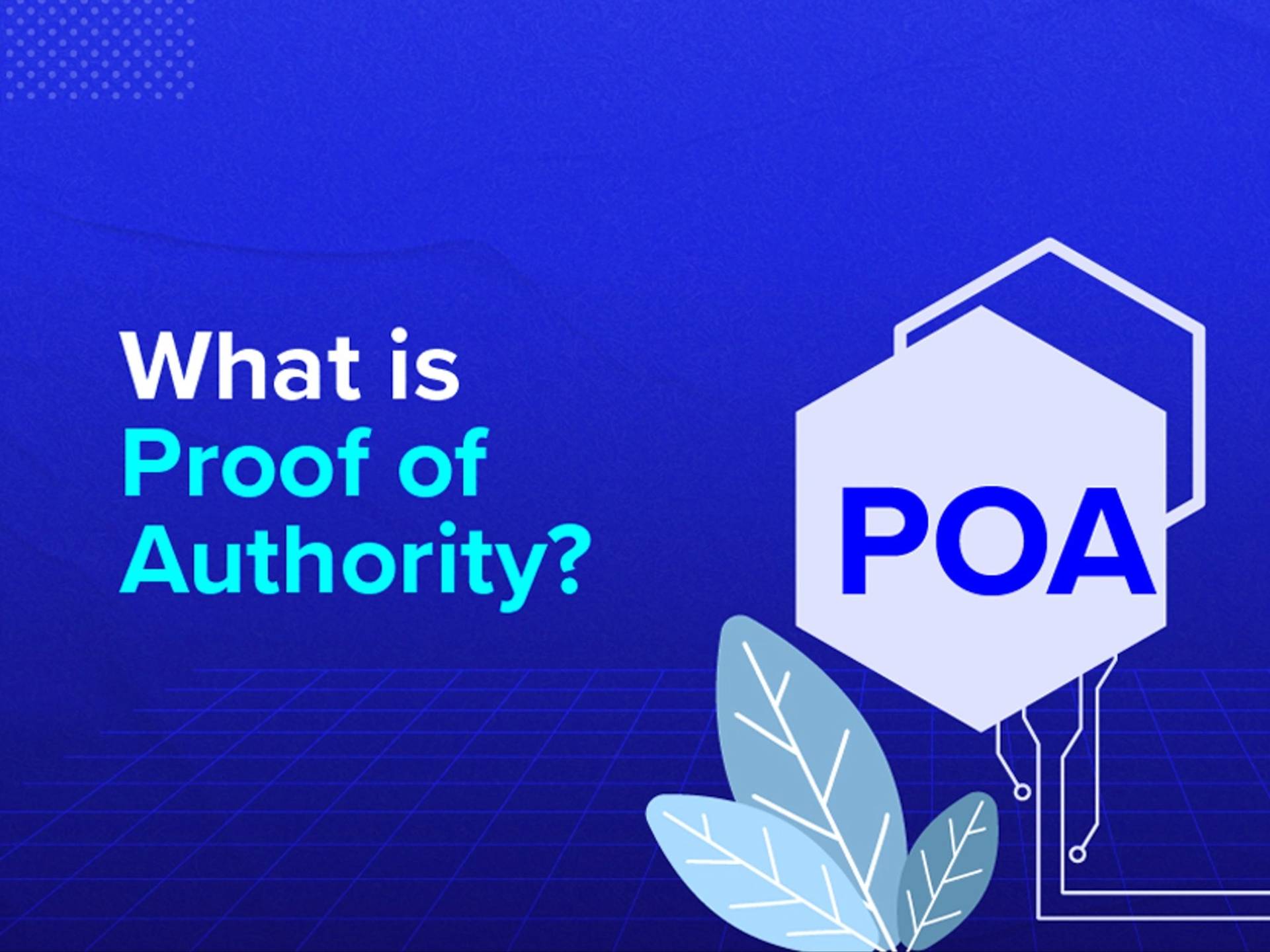위키 구독하기
Share wiki
Bookmark
Proof of Authority (PoA)
Proof of Authority (PoA)
**권한 증명(PoA)**는 블록체인 네트워크에서 승인된 기관만 트랜잭션을 검증할 수 있도록 허용하는 합의 시스템입니다. PoA는 알려지고 신뢰할 수 있는 검증자가 블록을 생성하고 따라서 네트워크에 컴퓨팅 성능을 제공하는 대체 합의 메커니즘입니다. 이는 지분으로서 신원을 사용하는 비잔틴 장애 허용(BFT) 알고리즘을 사용하여 상대적으로 빠른 트랜잭션을 가능하게 합니다. [1][7]
개요
권한 증명(PoA)은 검증자 그룹이 이미 권한으로 선택되는 합의 방법입니다. 그들의 임무는 새로 추가된 모든 신원을 확인하고, 트랜잭션을 검증하고, 네트워크에 추가할 블록을 검증하는 것입니다. 네트워크의 효율성과 보안을 보장하기 위해 검증자 그룹은 일반적으로 소규모(~25개 이하)로 유지됩니다. [2]
권한 증명에서 기계는 다음 섹션에서 자세히 설명하는 엄격한 심사 과정을 통과하여 새로운 블록을 생성할 권한을 얻습니다. 결과적으로 신뢰할 수 있는 검증 기계가 PoA 블록체인을 보호합니다. 이러한 시스템 관리자는 블록과 트랜잭션을 확인하는 사전 승인된 참가자입니다. [1]
권한 증명(PoA)은 지분 증명(PoS)의 향상된 버전으로, 검증자의 신원이 네트워크의 지분으로 사용됩니다. [2]
노드는 새로운 블록을 생성할 권한을 받으려면 필수 프로세스를 완료하여 자신을 인증해야 합니다. 검증자는 플랫폼에서 가지고 있는 것과 동일한 신원으로 정부 발행 문서를 사용하여 공개 공증 데이터베이스에 자신을 등록해야 합니다. 따라서 블록과 트랜잭션은 이미 신원이 확인되고 시스템의 권한으로 작용하는 참가자에 의해 검증됩니다. [2]
제한된 수의 사용자에게 권한이 부여됨에 따라 PoA 합의는 공용 블록체인이 아닌 개인 네트워크에 대한 솔루션으로 채택될 수 있습니다.
역사
PoA는 2017년 3월 개발자 그룹( Gavin Wood가 명명)에 의해 이더리움 프로토콜 기반 블록체인으로 제안되었습니다. 이더리움의 Ropsten 테스트 네트워크에 대한 스팸 공격 문제를 해결하기 위해 개발되었습니다. 새로운 네트워크는 Kovan으로 명명되었으며, 이는 오늘날 모든 이더리움 사용자가 사용하는 주요 테스트 네트워크입니다.
PoA와 다른 알고리즘 비교
PoA는 블록체인 분야의 수많은 합의 알고리즘 중 하나이며, PoW 및 PoS와 같은 다른 인기 알고리즘과 대조됩니다. PoW는 원래의 합의 알고리즘이며, 마이너가 블록을 생성하고 검증하기 위해 복잡한 수학 문제를 풀어야 합니다. 안전하고 분산되어 있지만 느리고 비용이 많이 들며 낭비적입니다. PoS는 네트워크에 참여하기 위해 토큰이나 코인을 잠가야 하는 대체 합의 알고리즘입니다. PoW보다 빠르고 저렴하며 친환경적이지만 보안이 덜하고 중앙 집중화되기 쉽습니다. Proof of Burn(PoB)은 PoW와 PoS를 결합하여 상호 절충점을 맞추는 하이브리드 합의 알고리즘입니다. PoS보다 안전하고 분산되어 있지만 PoA보다 복잡하고 효율성이 떨어집니다. [6]
권한 증명의 작동 방식
사전 승인된 검증자는 소프트웨어를 사용하여 트랜잭션을 블록으로 구성합니다. 이 프로세스는 자동화되어 있으므로 검증자는 컴퓨터를 지속적으로 모니터링할 필요가 없습니다. 그러나 이는 검증자가 컴퓨터를 양호한 상태로 유지해야 함을 의미합니다.
평판 메커니즘의 본질은 검증자 신원에 대한 신뢰입니다. 약한 후보를 제거하기 위해 복잡한 프로세스가 필요합니다. 이는 모든 검증자가 동일한 절차를 따르도록 보장하여 시스템의 무결성과 신뢰성을 보장합니다.
PoA 알고리즘으로 인해 검증자가 될 권한을 받은 사용자는 평점을 높게 유지할 동기가 있습니다. 검증자는 실제 신원과 연결된 평판을 손상시키지 않기 위해 안정적인 트랜잭션 프로세스를 유지하도록 동기가 부여됩니다. 결과적으로 대부분의 사용자는 어렵게 얻은 검증자 역할을 소중히 여깁니다. [1]
권한 설정
검증자가 설정되려면 충족해야 하는 세 가지 주요 조건은 다음과 같습니다. [5]
- 공개적으로 사용 가능한 도메인에서 정보를 교차 확인할 수 있는 가능성을 가진 신원이 공식적으로 온체인에서 확인되어야 합니다.
- 블록을 검증할 권한을 얻고 가치 있게 만들기 위해 자격을 얻기 어려워야 합니다. (예: 잠재적인 검증자는 공개 공증인 자격증을 취득해야 함)
- 권한을 설정하기 위한 확인 및 절차에 완전한 통일성이 있어야 합니다.
장점
· 높은 트랜잭션 속도.
· 고성능 하드웨어가 필요하지 않습니다.
· PoA 네트워크는 PoW 블록체인에 비해 확장성이 매우 뛰어납니다.
· 전력 소모량이 적습니다.
· 낮은 트랜잭션 수수료.
· 승인된 네트워크 노드에 의한 고정 시간 간격으로 순차적 블록 생성. 이는 트랜잭션 유효성 속도를 높입니다.
· 노드 간 합의에 도달하기 위해 통신이 필요하지 않습니다.
· 네트워크 작동은 사용 가능한 진정한 노드 수와 무관합니다.
· 노드가 위조자가 될 가능성은 지분과 전체 보유량 모두에 따라 달라집니다.
단점
· 기반 네트워크는 분산화가 부족합니다.
· 검증자의 신원이 네트워크에 표시됩니다.
· 검열 저항을 보장하지 않습니다.
사용 사례
- 테스트넷
PoA 합의는 메인넷에서 출시하기 전에 기능을 테스트하기 위한 제어 환경을 제공하는 데 이상적입니다. 이더리움의 세 가지 테스트넷인 Kovan, Goerli 및 Rinkeby는 권한 증명을 사용합니다. - 개인 블록체인
PoA는 구성원 간에 어느 정도의 신뢰가 이미 존재하는 블록체인 컨소시엄 및 기타 개인 네트워크와 같은 엔터프라이즈급 네트워크에 가장 적합합니다. - 사이드체인
양방향 브리지를 통해 상위 블록체인에 연결되어 병렬로 실행되는 블록체인 유형인 사이드체인에도 좋은 옵션입니다. 이에 대한 예로는 신원이 공개적이고 검증 가능한 사전 선택된 검증자에 의존하는 이더리움의 공용 사이드체인인 POA 네트워크가 있습니다. [4]
잘못된 내용이 있나요?
